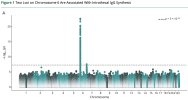Genetic Risk Variants for Multiple Sclerosis and Other Loci Linked to Intrathecal Immunoglobulin G Synthesis
BACKGROUND AND OBJECTIVES
Intrathecal synthesis of immunoglobulin G (IgG) is a key feature of multiple sclerosis (MS) and a prognostic marker for the disease course. Although previous studies identified 2 genetic regions—the major histocompatibility complex (MHC) region on chromosome 6 and the immunoglobulin heavy chain constant (IGHC) locus on chromosome 14—associated with intrathecal IgG synthesis in MS, the genetic underpinnings remain insufficiently understood.
METHODS
We conducted a genome-wide association study on intrathecal IgG synthesis using the IgG index to identify individuals with (≥0.7) or without (<0.7) quantitative intrathecal synthesis. We used logistic regression models adjusting for sex, age, and population structure. We performed secondary analyses to examine associations between identified loci and the extent of intrathecal IgG synthesis and the presence and extent of intrathecal immunoglobulin A and M synthesis. We further conducted association analyses for imputed human leukocyte antigen alleles and analyzed whether a higher genetic burden for MS risk—quantified through polygenic risk scores—is associated with intrathecal IgG synthesis.
RESULTS
In the discovery cohort (n = 3,934), we identified a novel genome-wide significant association of the intronic variant rs844586 (p = 1.48 × 10−8) in the sterile alpha motif domain containing 5 (SAMD5) gene on chromosome 6, with intrathecal IgG synthesis. We could confirm this association in a replication cohort (n = 1,094) and demonstrated that it is independent of a previously described association signal at the MHC region. In a subset (n = 1,413), we further identified rs1407 as a potential causal variant (p = 3.80 × 10−11, posterior inclusion probability = 0.92) for the previously reported association signal at the IGHC locus with the extent of intrathecal IgG synthesis. In addition, we demonstrated that a higher genetic burden for MS susceptibility, both within and outside of the MHC region, is associated with a higher likelihood of and a more pronounced intrathecal IgG synthesis.
DISCUSSION
Our study revealed a previously unknown association between an intronic variant in SAMD5 with intrathecal IgG synthesis and identified a potential causal variant within the IGHC locus. It further provides evidence for possible effects of known MS risk variants on disease severity through their effect on the intrathecal humoral immune response, a prognostic marker for the disease course.
Web | PDF | Neurology: Neuroimmunology & Neuroinflammation | Open Access
Pukaj, Albert; Harroud, Adil; Shchetynsky, Klementy; Wirsching, Laura; Peters, Lucy; Andlauer, Till Fm; Pääkkönen, Kimmo; Bos, Steffan D; Moylett, Sinéad; Dubois, Bénédicte; Llufriu, Sara; Luessi, Felix; Tackenberg, Björn; Kowarik, Markus C; Then Bergh, Florian; Trebst, Corinna; Tumani, Hayrettin; Wildemann, Brigitte; Bayas, Antonios; Havla, Joachim; Kümpfel, Tania; Knop, Matthias; Genetics Center, Regeneron; Stridh, Pernilla; Hillert, Jan A; Olsson, Tomas; Alfredsson, Lars; Cotsapas, Chris; Flinstad Harbo, Hanne; Zipp, Frauke; Saarela, Janna; Baranzini, Sergio E; Berthele, Achim; Kockum, Ingrid; Hemmer, Bernhard; Gasperi, Christiane; null, null; Zinevych, Iaroslav; Grummel, Verena; Uibel, Paula; Flaskamp, Martina; Mühlau, Mark; Martinelli-Boneschi, Filippo; Oturai, Anette; Villoslada, Pablo; Esposito, Federica; d’Alfonso, Sandra; Henry, Roland G; Jagodic, Maja; Goris, An; Sawcer, Stephen J; Jónsdóttir, Ingileif; Stefánsson, Kári
BACKGROUND AND OBJECTIVES
Intrathecal synthesis of immunoglobulin G (IgG) is a key feature of multiple sclerosis (MS) and a prognostic marker for the disease course. Although previous studies identified 2 genetic regions—the major histocompatibility complex (MHC) region on chromosome 6 and the immunoglobulin heavy chain constant (IGHC) locus on chromosome 14—associated with intrathecal IgG synthesis in MS, the genetic underpinnings remain insufficiently understood.
METHODS
We conducted a genome-wide association study on intrathecal IgG synthesis using the IgG index to identify individuals with (≥0.7) or without (<0.7) quantitative intrathecal synthesis. We used logistic regression models adjusting for sex, age, and population structure. We performed secondary analyses to examine associations between identified loci and the extent of intrathecal IgG synthesis and the presence and extent of intrathecal immunoglobulin A and M synthesis. We further conducted association analyses for imputed human leukocyte antigen alleles and analyzed whether a higher genetic burden for MS risk—quantified through polygenic risk scores—is associated with intrathecal IgG synthesis.
RESULTS
In the discovery cohort (n = 3,934), we identified a novel genome-wide significant association of the intronic variant rs844586 (p = 1.48 × 10−8) in the sterile alpha motif domain containing 5 (SAMD5) gene on chromosome 6, with intrathecal IgG synthesis. We could confirm this association in a replication cohort (n = 1,094) and demonstrated that it is independent of a previously described association signal at the MHC region. In a subset (n = 1,413), we further identified rs1407 as a potential causal variant (p = 3.80 × 10−11, posterior inclusion probability = 0.92) for the previously reported association signal at the IGHC locus with the extent of intrathecal IgG synthesis. In addition, we demonstrated that a higher genetic burden for MS susceptibility, both within and outside of the MHC region, is associated with a higher likelihood of and a more pronounced intrathecal IgG synthesis.
DISCUSSION
Our study revealed a previously unknown association between an intronic variant in SAMD5 with intrathecal IgG synthesis and identified a potential causal variant within the IGHC locus. It further provides evidence for possible effects of known MS risk variants on disease severity through their effect on the intrathecal humoral immune response, a prognostic marker for the disease course.
Web | PDF | Neurology: Neuroimmunology & Neuroinflammation | Open Access

